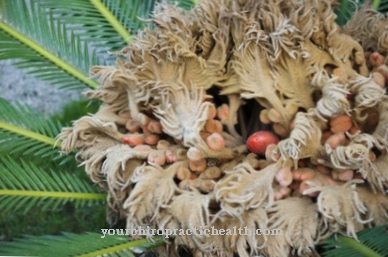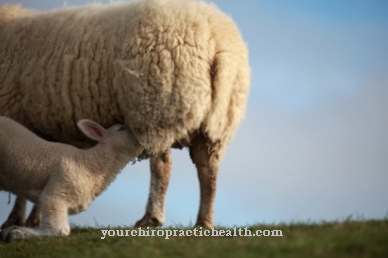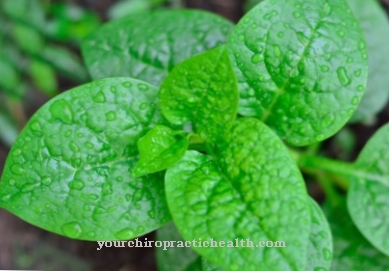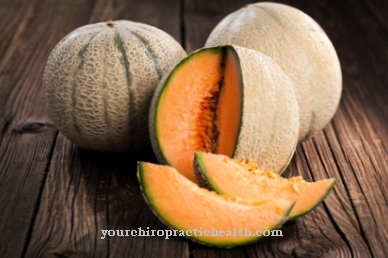The Chayote is an edible climber from Latin America that belongs to the cucurbit family. Their fist-sized fruits are pear-shaped and are also called chayote. The low-calorie vegetable is now grown in numerous subtropical and tropical countries around the world and used there for a variety of traditional dishes.
What you should know about the chayote

Chayote belongs to the pumpkin family and is therefore closely related to pumpkins, melons and cucumbers. The perennial plant is extremely fast-growing and, in good conditions, forms shoots several meters long, which climb upwards at all suitable climbing opportunities.
In addition to leaves the size of a hand, there are both male and female flowers on these shoots. The fruits that emerge after fertilization usually have a pear-like shape and usually reach the size of a man's fist. Some types of chayote are similar in shape and size to mangoes. However, the surface shows elongated furrows even when fresh. The skin of the chayote fruit can range from a comparatively light shade of green to a rich dark green. With a few exceptions, the skin of the chayote is very smooth. Only very dark green varieties sometimes have short and mostly soft spines. The pulp of the chayote is also greenish. It just has a faint taste of its own, reminiscent of cucumber or potatoes.
Stronger variants can also taste a little nutty or like kohlrabi.In the middle of the chayote, unlike other fruits from the pumpkin plant family, there is a single elongated core that is only edible to a limited extent. Under suitable conditions it germinates very quickly and without human intervention. However, the chayote is not frost-resistant. The chayote originally comes from the subtropical regions of Central America and was already used as a vegetable by the Aztecs and Mayans. Since it is extremely easy to care for, it can now be found in all tropical and subtropical growing areas of the world.
It is particularly widespread in Brazil, India, Indonesia and the Philippines, but also in Australia and occasionally in the Mediterranean region. Most of the time, wooden structures are used as climbing aids for their cultivation, which allow the ripe chayote to be plucked from below during harvest. Such wooden scaffolds, reminiscent of pergolas, are also popular in private gardens, as they also provide shade for people or other crops grown underneath. In addition, the cultivation of chayote requires little effort, as it does not require any further care measures apart from the harvest. A single chayote plant bears up to 300 fruits a year.
In addition to the actual fruits, all other parts of the chayote plant are also edible. In many traditional dishes, leaves and sprouts of chayote are available in addition to the fruit. In Europe, however, only the actual chayote fruits are usually available.
Importance to health
In the traditional herbal medicine of Central America and Southeast Asia, the leaves of the chayote are mainly used. These are dried and made into tea. This has a diuretic effect and can relieve the symptoms of kidney stones.
The chayote fruits are also beneficial for health. With a very low number of calories, they have a high proportion of vitamins and trace elements as well as antioxidants. As a result, the consumption of chayote has a positive effect on cell renewal and the entire cardiovascular system. Thanks to the low carbohydrate content and the great satiety effect, chayote is particularly suitable for nutrition in the case of existing diabetes. Chayote can also be used without hesitation in reducing diets. The weight loss is supported by the draining and diuretic properties of the chayote.
Ingredients & nutritional values
| Nutritional information | Amount per 100 gram |
| Calories 19 | Fat content 0.1 g |
| cholesterol 0 mg | sodium 2 mg |
| potassium 125 mg | carbohydrates 4.5 g |
| Fiber 1.7 g | protein 0.8 g |
With only 22 kcal per 100 grams, the chayote is unusually low in calories, even for a vegetable. Like the cucumbers and melons related to it, the fruit consists primarily of water. The content of fat and carbohydrates, on the other hand, is extremely low.
The available carbohydrates are mainly in the form of fiber. The chayote, on the other hand, is very rich in vitamins, especially in vitamin C and provitamin A. In addition, the chayote contains essential minerals such as calcium, potassium and iron as well as various amino acids.
Intolerances & allergies
Chayote is a very light vegetable that is usually extremely digestible. There are no known allergies or intolerances to chayote. However, chayote contains small amounts of fructose, histamine and salicylic acid. Anyone who is known to suffer from a corresponding intolerance should consult their doctor before consuming chayote.
Shopping & kitchen tips
Chayote is commercially available under a variety of names. Depending on the growing area, the fruit can also be called Pepinello, Mirliton, Chow chow or Xuxu be found in the supermarket. Since chayotes are grown in subtropical and tropical regions, they are available all year round.
The fruits are usually harvested unripe and ripen during transport and storage. When shopping, you should make sure that the chayote is still firm and the shell feels smooth and plump. This is a sign of freshness. The irregular elongated notches on the surface, on the other hand, say nothing about the degree of freshness. If the chayote fruits are not to be used immediately, they can easily be stored in the vegetable compartment of the refrigerator.
There they stay fresh for a week or two. Sliced chayote, on the other hand, should be wrapped in foil and prepared within three days. Before preparation, the chayote should be peeled and its core removed. Since the fruit exudes a sticky juice, it makes sense to do this under running water.
Preparation tips
Chayote tastes slightly sweet, but is usually prepared as a vegetable. The green fruits are particularly suitable for hearty, strongly spiced stews and stews. Thanks to its subtle taste, chayote is an excellent addition to various meat dishes. If the chayote is halved and the core removed, it can also be filled with meat, vegetables or seafood and baked in the oven. The water-rich chayote can also be prepared as a raw fruit or salad. Dishes made from chayote sprouts are particularly sophisticated.
Since chayote kernels germinate very easily, it is possible to grow them yourself in the kitchen at home. Since chayote comes from Central America, but has also been grown in India, Southeast Asia and the Mediterranean for several centuries, there are a variety of traditional recipes for chayote. The light vegetables are very versatile and can therefore easily be used to modify classic European dishes. This is particularly recommended in connection with reduction diets or low-carbohydrate diets as well as with an existing diabetes disease.
















.jpg)
.jpg)



.jpg)






